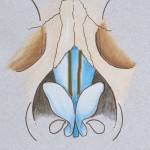
It is appreciated today that there are other issues of anatomy that make a contribution towards the ease of nasal airflow other than the alignment of the septal cartilage. There are a series of four nasal valves inside the nose which make contributions to airflow. One of these in the internal nasal valve. The internal valves exist on each side of the nose and consist of the lower end of the upper lateral cartilage, the septum, and the soft tissue around the base of the nose. The valve angle should exceed 15 degrees. You can easily see the value of this internal nasal valve by pinching your nose slightly behind the tip and notice how much harder it is to breathe. This valve area is particularly prone to dysfunction from anything that causes it to collapse, most notably previous rhinoplasty tip surgery, trauma nasal injuries, and the aging process which can cause the tip to droop.
It has been recognized for nearly twenty-five years that the internal valve area can be opened up by the use of spreader grafts between the septum and the upper lateral cartilage. While cartilage is commonly used, other materials may be used as well. By pushing out the tail end of the upper lateral cartilage, the internal nasal valve angle is expanded. This is not a complex surgical manuever to do but it is usually best done through the open rhinoplasty approach and one must be facile with cartilage harvesting methods.
The best candidates for spreader grafts as those patients that have a visible narrowing or pinching to the middle-third of the nose, also known as the middle vault. In some cases, there may only be a slight asymmetry of the middle vault area on one side, but if it matches the side of the nose were airflow is less, then internal nasal valve narrowing is likely present. Examination inside the nose can sometimes show a ‘pinched’ valve but there is not absolute way to measure this angle. Many use the ‘Cottle manuever’ (stretching out the base of the nose with one’s finger or lifting up the nostril rim) to see if improvement in breathing results. But this clinical test is not absolute as anyone will show easier breathing even if they don’t have known breathing difficulties.
The use of spreader grafts in rhinoplasty is helpful both as a treatment for identified patients with middle vault collapse as well as a preventative technique. For patients undergoing cosmetic rhinoplasty with narrow noses (high risk for breathing difficulties after rhinoplasty), the prophylactic use of spreader grafts may prevent the potential for airway obstruction after surgery. Spreader grafts are also particularly useful in performing rhinoplasty in twisted or crooked noses where they can help support pushing a deviated septum and tip back towards the midline and keeping it there long-term.
Dr. Barry Eppley
Indianapolis, Indiana


